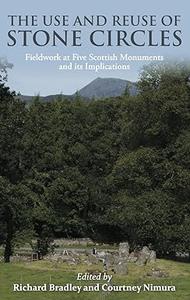
Free Download Courtney Nimura, Richard Bradley, "The Use and reuse of stone circles: Fieldwork at five Scottish monuments and its implications"
English | 2016 | pages: 240 | ISBN: 1785702432 | EPUB | 19,1 mb
The study of stone circles has long played a major role in British and Irish archaeology, and for Scotland most attention has been focused on the large monuments of Orkney and the Western Isles. Several decades of fieldwork have shown how these major structures are likely to be of early date and recognized that that smaller settings of monoliths had a more extended history. Many of the structures in Northern Britain were reused during the later Bronze Age, the Iron Age and the early medieval period. A series of problems demand further investigation including: when were the last stone circles built? How did they differ from earlier constructions? How were they related to henge monuments, especially those of Bronze Age date? How frequently were these places reused, and did this secondary activity change the character of those sites? This major new assessment first presents the results of fieldwork undertaken at the Scottish recumbent stone circle of Hillhead; the stone circles of Waulkmill and Croftmoraig, the stone circle and henge at Hill of Tuach at Kintore; and the small ring cairn at Laikenbuie in Inverness-shire. Part 2 brings together the results of these five projects and puts forward a chronology for the construction and primary use of stone circles, particularly the Chalcolithic and Bronze Age examples. It considers the reuse of stone circles, long after they were built, and discusses four neighboring stone circles in Aberdeenshire which display both similarities and contrasts in their architecture, use of raw materials, associated artefacts and structural sequences. Finally, a reassessment and reinterpretation of Croftmoraig and its sequence is presented: the new interpretation drawing attention to ways of thinking about these monuments which have still to fulfill their potential.
Table of Contents
Table of Contents
Acknowledgments
Abbreviations
Preface. The contents of the volume (Richard Bradley)
Summary
Part 1. Excavations at five Scottish monuments
Chapter 1. The development of the project (Richard Bradley)
Henges and stone settings
The limits of classification
Patterns of later reuse
Developments during the project
Chapter 2. Excavations at Hillhead, Tarland, Aberdeenshire: a recumbent stone circle and its history (Richard Bradley and Amanda Clarke)
The structure of the monument
Dating evidence
Finds (Richard Bradley and Fiona Shapland)
The surroundings of the monument (Moyra Simon and Jane Summers)
The character of the principal monument (Richard Bradley)
Chapter 3. Excavations at Waulkmill, Tarland, Aberdeenshire: a Neolithic pit, Roman Iron Age burials and an earlier prehistoric stone circle (Richard Bradley, Amanda Clarke and Fraser Hunter)
Introduction
Nineteenth century discoveries and observations
The 2012 excavation
The Neolithic pit (Alison Sheridan and Richard Bradley)
The Bronze Age stone circle
The Roman Iron Age burials (with a contribution by Fiona Shapland
Roman Iron Age artefacts Fraser Hunter, Penelope Walton Rogers, Maureen Young, Hilary Cool and Mark Hall)
Discussion of the Iron Age phase: a context for Roman finds on Deeside (Fraser Hunter)
Chapter 4. Croftmoraig stone circle, Perth and Kinross: a reinterpretation in the light of fresh excavation (Richard Bradley)
The Croftmoraig stone circle
The 1965 excavation
The aims of the 2012 excavation
The research design for the 2102 excavation
The methods used in the 1965 excavation
Details of the 2012 excavation
The excavated material (Richard Bradley and Fiona Shapland)
New evidence of sequence
Conclusions
Chapter 5. The Hill of Tuach, Kintore, Aberdeenshire: the excavation of a small stone circle and henge (Richard Bradley and Amanda Clarke)
Background to the project (Richard Bradley, Amanda Clarke and Alison Sheridan)
The monument today (Richard Bradley and Amanda Clarke)
Excavation in 2011 (Richard Bradley and Amanda Clarke)
The distribution of excavated artefacts
The excavated artefacts (Alison Sheridan, Trevor Cowie, Lore Troalen and Penelope Walton Rogers, Richard Bradley and Rosemary Stewart)
The cremated human remains
Cremated human remains from the 1855 excavation (Cecilia Medina-Pettersson and Fiona Shapland)
Charcoal found during the 2011 excavation (Phil Austin)
Pollen analysis (Alex Brown)
Radiocarbon dates
Synthesis (Richard Bradley)
Chapter 6. Laikenbuie, Auldearn, Inverness-shire: excavation of an Early Iron Age ring cairn and other features (Ronnie Scott and Annette Jack)
Introduction
Above-ground structures
Sample excavation 2003-2006
Radiocarbon dates
Part Two. The Excavated monuments in their wider contexts
Chapter 7. After the Great Stone Circles (Richard Bradley)
The first stone circles
Recumbent stone circles, Clava Cairns and other monuments
The Great Stone Circles and their successors
Building the Great Stone Circles
Similarities and contrasts
The structural sequence at Clava Cairns and recumbent stone circles
Subsequent developments in Northern Britain
Smaller stone settings of the Early and Middle Bronze Ages in the north
The last ring cairns and kerb cairns in the north
Closing by enclosing
Chapter 8. Histories of reuse (Richard Bradley)
Introduction: closing and reopening
Later Bronze Age reuse (Richard Bradley)
Stone circles and roundhouses (Richard Bradley)
Roman Iron Age activity at stone monuments in north-east Scotland (Fraser Hunter and Richard Bradley)
The reuse of older monuments in the Pictish period (Richard Bradley)
Chapter 9. The extent of variation: four stone circles in Cromar in the light of recent fieldwork (Richard Bradley)
Chapter 10. Croftmoraig: the anatomy of a stone circle (Richard Bradley)
From 1965 to 2012: a change of emphasis
The local setting – nature, culture and monument building
Enhancing the natural monument
From stone to timber
From timber back to stone
Ending
References
Index










Leave a Reply
You must be logged in to post a comment.